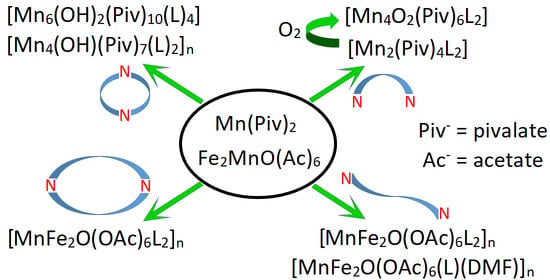Versatile Reactivity of MnII Complexes in Reactions with N-Donor Heterocycles: Metamorphosis of Labile Homometallic Pivalates vs. Assembling of Endurable Heterometallic Acetates
Abstract
:1. Introduction
2. Results and Discussion
2.1. Synthesis
2.2. Crystal and Molecular Structures
2.2.1. Compounds 1 and 2
2.2.2. Compounds 3 and 4
2.2.3. Compound 5
2.2.4. Compound 6
2.2.5. Compound 7
2.2.6. Compound 8
2.2.7. Compounds 9–11
- (1)
- MnFe2 units in 1D chains, bound to two bridging 4,4′-bipy and one additional non-bridging 4,4′-bipy (type A);
- (2)
- MnFe2 units in {MnFe2O(OAc)6(4,4′-bipy)3} residues (type B);
- (3)
- MnFe2 unit in 1D chains, bound to two bridging 4,4′-bipy and one type B unit (type C).
2.2.8. Complexes 10 and 11
2.3. Thermal Stability and Sorption Properties of 11·3.5DMF
2.4. EPR Spectroscopy
2.5. Magnetic Properties of Complexes 1, 2, 7·2MeCN and 11·3.5DMF
2.5.1. Magnetic Properties of Complexes 1 and 2
2.5.2. Magnetic Properties of Complex 7 ·2MeCN
2.5.3. Magnetic Properties of Complex 11·3.5DMF
3. Experimental
3.1. Materials and Methods
3.2. Synthesis
3.2.1. Synthesis of [Mn2(Piv)4(2,2′-bipy)2] (1) and [Mn2(Piv)4(phen)2] (2)
3.2.2. Synthesis of [Mn4O2(Piv)6(2,2′-bipy)2]·MeCN (3·MeCN) (3) and [Mn4O2(Piv)6(phen)2]· 0.5MeCN (4·0.5MeCN) (4)
3.2.3. Synthesis of [Mn6(OH)2(Piv)10(pym)4] (5) and Synthesis of [Mn6O2(Piv)10(pym)2]n (6)
3.2.4. Synthesis of [Mn4(OH)(Piv)7(pz)2]n∙2nMeCN (7∙2MeCN)
3.2.5. Synthesis of [Mn4Fe2O2(Piv)10(MeCN)2(HPiv)2]·2MeCN (8·2MeCN)
3.2.6. Synthesis of [MnFe2O(OAc)6(4,4′-bipy)2]n·2nDMF (9·2DMF)
3.2.7. Synthesis of [MnFe2O(OAc)6(bpe)2]n·2nDMF (10·2DMF)
3.2.8. Synthesis of [MnFe2O(OAc)6(bpe)(DMF)]n·3.5nDMF (11·3.5DMF)
3.3. X-ray Structure Determination
3.4. DFT Calculations
4. Conclusions
Supplementary Materials
Author Contributions
Funding
Institutional Review Board Statement
Informed Consent Statement
Data Availability Statement
Acknowledgments
Conflicts of Interest
Sample Availability
References
- Glaser, F.; Wenger, O.S. Recent Progress in the Development of Transition-Metal Based Photoredox Catalysts. Coord. Chem. Rev. 2020, 405, 213129. [Google Scholar] [CrossRef]
- Hazari, N.; Melvin, P.R.; Beromi, M.M. Well-Defined Nickel and Palladium Precatalysts for Cross-Coupling. Nat. Rev. Chem. 2017, 1, 0025. [Google Scholar] [CrossRef] [PubMed]
- Cooper, B.G.; Napoline, J.W.; Thomas, C.M. Catalytic Applications of Early/Late Heterobimetallic Complexes. Cat. Rev. 2012, 54, 1–40. [Google Scholar] [CrossRef]
- Bilyachenko, A.N.; Dronova, M.S.; Yalymov, A.I.; Lamaty, F.; Bantreil, X.; Martinez, J.; Bizet, C.; Shul’pina, L.S.; Korlyukov, A.A.; Arkhipov, D.E.; et al. Cage-like Copper(II) Silsesquioxanes: Transmetalation Reactions and Structural, Quantum Chemical, and Catalytic Studies. Chem. Eur. J. 2015, 21, 8758–8770. [Google Scholar] [CrossRef] [PubMed]
- Kirillov, A.M.; Kirillova, M.V.; Pombeiro, A.J.L. Homogeneous Multicopper Catalysts for Oxidation and Hydrocarboxylation of Alkanes. Adv. Inorg. Chem. 2013, 65, 1–31. [Google Scholar] [CrossRef]
- Masoomi, M.Y.; Morsali, A. Applications of Metal–Organic Coordination Polymers as Precursors for Preparation of Nano-Materials. Coord. Chem. Rev. 2012, 256, 2921–2943. [Google Scholar] [CrossRef]
- de la Rosa, L.A.G.; Méndez-Rojas, M.A. Direct Synthesis of Nanomaterials: Building Bridges between Metal Complexes and Nanomaterials. In Direct Synthesis of Metal Complexes; Elsevier: Amsterdam, The Neatherlands, 2018; pp. 317–337. ISBN 978-0-12-811061-4. [Google Scholar]
- Zauzolkova, N.; Dobrokhotova, Z.; Lermontov, A.; Zorina, E.; Emelina, A.; Bukov, M.; Chernyshev, V.; Sidorov, A.; Kiskin, M.; Bogomyakov, A.; et al. Step-by-Step Thermal Transformations of a New Porous Coordination Polymer [(H2O)5CuBa(Me2mal)2]n (Me2mal2−=dimethylmalonate): Thermal Degradation to Barium Cuprate. J. Solid State Chem. 2013, 197, 379–391. [Google Scholar] [CrossRef]
- Maniaki, D.; Pilichos, E.; Perlepes, S.P. Coordination Clusters of 3d-Metals That Behave as Single-Molecule Magnets (SMMs): Synthetic Routes and Strategies. Front. Chem. 2018, 6, 461. [Google Scholar] [CrossRef]
- Coronado, E. Molecular Magnetism: From Chemical Design to Spin Control in Molecules, Materials and Devices. Nat. Rev. Mater. 2020, 5, 87–104. [Google Scholar] [CrossRef]
- Gaita-Ariño, A.; Luis, F.; Hill, S.; Coronado, E. Molecular Spins for Quantum Computation. Nat. Chem. 2019, 11, 301–309. [Google Scholar] [CrossRef]
- Levitsky, M.M.; Bilyachenko, A.N.; Shubina, E.S.; Long, J.; Guari, Y.; Larionova, J. Magnetic cage-like metallasilsesquioxanes. Coord. Chem. Rev. 2019, 398, 213015. [Google Scholar] [CrossRef]
- Ferrando-Soria, J.; Vallejo, J.; Castellano, M.; Martínez-Lillo, J.; Pardo, E.; Cano, J.; Castro, I.; Lloret, F.; Ruiz-García, R.; Julve, M. Molecular magnetism, quo vadis? A historical perspective from a coordination chemist viewpoint. Coord. Chem. Rev. 2017, 339, 17–103. [Google Scholar] [CrossRef]
- Nandasiri, M.I.; Jambovane, S.R.; McGrail, B.P.; Schaef, H.T.; Nune, S.K. Adsorption, Separation, and Catalytic Properties of Densified Metal-Organic Frameworks. Coord. Chem. Rev. 2016, 311, 38–52. [Google Scholar] [CrossRef] [Green Version]
- Jeon, I.-R.; Clérac, R. Controlled Association of Single-Molecule Magnets (SMMs) into Coordination 15.Networks: Towards a New Generation of Magnetic Materials. Dalton Trans. 2012, 41, 9569. [Google Scholar] [CrossRef]
- Polunin, R.A.; Kolotilov, S.V.; Kiskin, M.A.; Cador, O.; Mikhalyova, E.A.; Lytvynenko, A.S.; Golhen, S.; Ouahab, L.; Ovcharenko, V.I.; Eremenko, I.L.; et al. Topology Control of Porous Coordination Polymers by Building Block Symmetry. Eur. J. Inorg. Chem. 2010, 2010, 5055–5057. [Google Scholar] [CrossRef]
- Kolotilov, S.V.; Cador, O.; Gavrilenko, K.S.; Golhen, S.; Ouahab, L.; Pavlishchuk, V.V. Assembly of Dinuclear CuII Rigid Blocks by Bridging Azido or Poly(Thiocyanato)Chromates: Synthesis, Structures and Magnetic Properties of Coordination Polymers and Polynuclear Complexes. Eur. J. Inorg. Chem. 2010, 2010, 1255–1266. [Google Scholar] [CrossRef]
- Lytvynenko, A.S.; Kolotilov, S.V.; Kiskin, M.A.; Cador, O.; Golhen, S.; Aleksandrov, G.G.; Mishura, A.M.; Titov, V.E.; Ouahab, L.; Eremenko, I.L.; et al. Redox-Active Porous Coordination Polymers Prepared by Trinuclear Heterometallic Pivalate Linking with the Redox-Active Nickel(II) Complex: Synthesis, Structure, Magnetic and Redox Properties, and Electrocatalytic Activity in Organic Compound Dehalogenation in Heterogeneous Medium. Inorg. Chem. 2014, 53, 4970–4979. [Google Scholar] [CrossRef] [PubMed]
- Polunin, R.A.; Kiskin, M.A.; Cador, O.; Kolotilov, S.V. Coordination Polymers Based on Trinuclear Heterometallic Pivalates and Polypyridines: Synthesis, Structure, Sorption and Magnetic Properties. Inorg. Chim. Acta 2012, 380, 201–210. [Google Scholar] [CrossRef]
- Botezat, O.; van Leusen, J.; Kravtsov, V.C.; Filippova, I.G.; Hauser, J.; Speldrich, M.; Hermann, R.P.; Krämer, K.W.; Liu, S.-X.; Decurtins, S.; et al. Interpenetrated (8,3)-c and (10,3)-b Metal–Organic Frameworks Based on {FeIII3} and {FeIII2CoII} Pivalate Spin Clusters. Cryst. Growth Des. 2014, 14, 4721–4728. [Google Scholar] [CrossRef]
- Botezat, O.; van Leusen, J.; Kögerler, P.; Baca, S.G. Tuning the Condensation Degree of {FeIIIn} Oxo Clusters via Ligand Metathesis, Temperature, and Solvents. Inorg. Chem. 2018, 57, 7904–7913. [Google Scholar] [CrossRef]
- Botezat, O.; van Leusen, J.; Kravtsov, V.C.; Kögerler, P.; Baca, S.G. Ultralarge 3d/4f Coordination Wheels: From Carboxylate/Amino Alcohol-Supported {Fe4Ln2} to {Fe18Ln6} Rings. Inorg. Chem. 2017, 56, 1814–1822. [Google Scholar] [CrossRef]
- Taguchi, T.; Daniels, M.R.; Abboud, K.A.; Christou, G. Mn4, Mn6, and Mn11 Clusters from the Use of Bulky Diphenyl(pyridine-2-yl)methanol. Inorg. Chem. 2009, 48, 9325–9335. [Google Scholar] [CrossRef] [PubMed]
- Mondal, K.C.; Song, Y.; Mukherjee, P.S. Self-Assembly of a Mn9 Nanoscopic Mixed-Valent Cluster: Synthesis, Crystal Structure, and Magnetic Behavior. Inorg. Chem. 2007, 46, 9736–9742. [Google Scholar] [CrossRef]
- Wemple, M.W.; Tsai, H.-L.; Wang, S.; Claude, J.P.; Streib, W.E.; Huffman, J.C.; Hendrickson, D.N.; Christou, G. Tetranuclear and Octanuclear Manganese Carboxylate Clusters: Preparation and Reactivity of (NBun4)[Mn4O2(O2CPh)9(H2O)] and Synthesis of (Nbun4)2[Mn8O4(O2CPh)12(Et2Mal)2(H2O)2] with a “Linked-Butterfly” Structure. Inorg. Chem. 1996, 35, 6437–6449. [Google Scholar] [CrossRef]
- Boskovic, C.; Wernsdorfer, W.; Folting, K.; Huffman, J.C.; Hendrickson, D.N.; Christou, G. Single-Molecule Magnets: Novel Mn8 and Mn9 Carboxylate Clusters Containing an Unusual Pentadentate Ligand Derived from Pyridine-2,6-Dimethanol. Inorg. Chem. 2002, 41, 5107–5118. [Google Scholar] [CrossRef]
- Polunin, R.A.; Kolotilov, S.V.; Kiskin, M.A.; Gavrilenko, K.S.; Ouahab, L.; Eremenko, I.L.; Novotortsev, V.M.; Pavlishchuk, V.V. Structures and Sorption Properties of the Coordination Polymers Built up of 3d Metal Carboxylate Polynuclear Complexes. Russ. Chem. Bull. 2010, 59, 1217–1224. [Google Scholar] [CrossRef]
- Köberl, M.; Cokoja, M.; Herrmann, W.A.; Kühn, F.E. From Molecules to Materials: Molecular Paddle-Wheel Synthons of Macromolecules, Cage Compounds and Metal–Organic Frameworks. Dalton Trans. 2011, 40, 6834. [Google Scholar] [CrossRef] [PubMed]
- Duncan, J.F.; Kanekar, C.R.; Mok, K.F. Some Trinuclear Iron(III) Carboxylate Complexes. J. Chem. Soc. Inorg. Phys. Theor. 1969, 480–482. [Google Scholar] [CrossRef]
- Blake, A.B.; Yavari, A.; Hatfield, W.E.; Sethulekshmi, C.N. Magnetic and Spectroscopic Properties of Some Heterotrinuclear Basic Acetates of Chromium(III), Iron(III), and Divalent Metal Ions. J. Chem. Soc. Dalton Trans. 1985, 2509–2520. [Google Scholar] [CrossRef]
- Gavrilenko, K.S.; Vértes, A.; Vanko, G.; Kiss, L.F.; Addison, A.W.; Weyhermüller, T.; Pavlishchuk, V.V. Synthesis, Magnetochemistry, and Spectroscopy of Heterometallic Trinuclear Basic Trifluoroacetates [Fe2M(µ3-O)(CF3COO)6(H2O)3]·H2O (M = Mn, Co, Ni). Eur. J. Inorg. Chem. 2002, 2002, 3347–3355. [Google Scholar] [CrossRef]
- Lytvynenko, A.S.; Kolotilov, S.V.; Cador, O.; Gavrilenko, K.S.; Golhen, S.; Ouahab, L.; Pavlishchuk, V.V. Porous 2D Coordination Polymeric Formate Built up by Mn(II) Linking of Fe3O Units: Influence of Guest Molecules on Magnetic Properties. Dalton Trans. 2009, 3503–3509. [Google Scholar] [CrossRef]
- Kiskin, M.; Zorina-Tikhonova, E.; Kolotilov, S.; Goloveshkin, A.; Romanenko, G.; Efimov, N.; Eremenko, I. Synthesis, Structure, and Magnetic Properties of a Family of Complexes Containing a CoII2DyIII Pivalate Core and a Pentanuclear CoII4DyIII Derivative. Eur. J. Inorg. Chem. 2018, 2018, 1356–1366. [Google Scholar] [CrossRef]
- Burkovskaya, N.P.; Orlova, E.V.; Kiskin, M.A.; Efimov, N.N.; Bogomyakov, A.S.; Fedin, M.V.; Kolotilov, S.V.; Minin, V.V.; Aleksandrov, G.G.; Sidorov, A.A.; et al. Synthesis, Structure, and Magnetic Properties of Heterometallic Trinuclear Complexes {MII—LnIII—MII} (MII = Ni, Cu; LnIII = La, Pr, Sm, Eu, Gd). Russ. Chem. Bull. 2011, 60, 2490–2503. [Google Scholar] [CrossRef]
- Lutsenko, I.A.; Kiskin, M.A.; Nikolaevskii, S.A.; Starikova, A.A.; Efimov, N.N.; Khoroshilov, A.V.; Bogomyakov, A.S.; Ananyev, I.V.; Voronina, J.K.; Goloveshkin, A.S.; et al. Ferromagnetically Coupled Molecular Complexes with a CoII2GdIII Pivalate Core: Synthesis, Structure, Magnetic Properties and Thermal Stability. ChemistrySelect 2019, 4, 14261–14270. [Google Scholar] [CrossRef]
- Reynolds, R.A.; Dunham, W.R.; Coucouvanis, D. Kinetic Lability, Structural Diversity, and Oxidation Reactions of New Oligomeric, Anionic Carboxylate−Pyridine Complexes. Inorg. Chem. 1998, 37, 1232–1241. [Google Scholar] [CrossRef] [PubMed]
- Yamaguchi, K.S.; Sawyer, D.T. The Redox Chemistry of Manganese(III) and –(IV) Complexes. Isr. J. Chem. 1985, 25, 164–176. [Google Scholar] [CrossRef]
- Pedersen, K.S.; Bendix, J.; Clérac, R. Single-Molecule Magnet Engineering: Building-Block Approaches. Chem. Commun. 2014, 50, 4396–4415. [Google Scholar] [CrossRef] [Green Version]
- Dincǎ, M.; Long, J.R. High-Enthalpy Hydrogen Adsorption in Cation-Exchanged Variants of the Microporous Metal−Organic Framework Mn3[(Mn4Cl)3(BTT)8(CH3OH)10]2. J. Am. Chem. Soc. 2007, 129, 11172–11176. [Google Scholar] [CrossRef]
- Kar, P.; Haldar, R.; Gómez-García, C.J.; Ghosh, A. Antiferromagnetic Porous Metal–Organic Framework Containing Mixed-Valence [MnII4MnIII2(μ4-O)2]10+ Units with Catecholase Activity and Selective Gas Adsorption. Inorg. Chem. 2012, 51, 4265–4273. [Google Scholar] [CrossRef]
- Li, C.-X.; Zeng, D.-F.; Chen, Y.-P.; Zhang, H.-H.; Sun, Y.-Q.; Chai, X.-C.; Lei, R.; Sun, R.-Q.; Huaxue, J. Syntheses and Crystal Structures of Two New Compounds: [Zn(2,2′-bipy)(L)Cl]2 and [Zn(phen)(L2)]2 (HL—3-Methylbenzoic Acid). Chin. J. Struct. Chem. 2009, 28, 1381–1386. [Google Scholar]
- Perlepes, S.P.; Libby, E.; Streib, W.E.; Folting, K.; Christou, G. The Reactions of Cu2(O2CMe)4(H2O)2 with 2,2′-Bipyridine (Bpy): Influence of the Cu: Bpy Ratio, and the Structure of a Linear Polymer Comprising Two Alternating Types of Cu2 Units. Polyhedron 1992, 11, 923–936. [Google Scholar] [CrossRef]
- Talismanova, M.O.; Sidorov, A.A.; Novotortsev, V.M.; Aleksandrov, G.G.; Nefedov, S.E.; Eremenko, I.L.; Moiseev, I.I. Unusual Transformation of the Urea Molecule Giving Rise to the NCO− Anion as a Bridging Ligand between Two CoII Atoms. Russ. Chem. Bull. 2001, 50, 2251–2253. [Google Scholar] [CrossRef]
- Zhang, Q.-Z.; Lu, C.-Z. Di-μ-Acetato-Bis[Bis(4-Aminobenzoato)(2,2′-Bipyridyl)Manganese(II)]. Acta Crystallogr. C 2005, 61, m78–m80. [Google Scholar] [CrossRef]
- Banerjee, S.; Rajakannu, P.; Butcher, R.J.; Murugavel, R. Auxiliary Ligand-Aided Tuning of Aggregation of Transition Metal Benzoates: Isolation of Four Different Types of Coordination Polymers. CrystEngComm 2014, 16, 8429–8441. [Google Scholar] [CrossRef]
- Goldberg, A.E.; Kiskin, M.A.; Kozyukhin, S.A.; Sidorov, A.A.; Eremenko, I.L. Binuclear Zinc Naphthoate Complex with 1,10-Phenanthroline: Synthesis, Structure, and Photoluminescence Properties. Russ. Chem. Bull. 2011, 60, 1012–1015. [Google Scholar] [CrossRef]
- Dey, D.; Roy, S.; Dutta Purkayastha, R.N.; Pallepogu, R.; McArdle, P. Zinc Carboxylates Containing Diimine: Synthesis, Characterization, Crystal Structure, and Luminescence. J. Mol. Struct. 2013, 1053, 127–133. [Google Scholar] [CrossRef]
- Li, X.-M.; Wang, Q.-W.; Liu, B.; Huaxue, J. Synthesis and Crystal Structure of a Zinc(II) Complex with 2-(4′-Chlorine-benzoyl)-benzoic Acid and 1,10-Phenanthroline. Chin. J. Struct. Chem. 2011, 30, 1646–1649. [Google Scholar]
- Baca, S.G.; Malaestean, I.L.; Keene, T.D.; Adams, H.; Ward, M.D.; Hauser, J.; Neels, A.; Decurtins, S. One-Dimensional Manganese Coordination Polymers Composed of Polynuclear Cluster Blocks and Polypyridyl Linkers: Structures and Properties. Inorg. Chem. 2008, 47, 11108–11119. [Google Scholar] [CrossRef]
- Evstifeev, I.S.; Kiskin, M.A.; Mironov, V.S.; Bogomyakov, A.S.; Sidorov, A.A.; Novotortsev, V.M.; Eremenko, I.L. 1D Nickel(II) Coordination Polymer with Pyrimidine and Pivalate Bridges: Synthesis, Structure and Magnetic Properties. Inorg. Chem. Commun. 2010, 13, 498–501. [Google Scholar] [CrossRef]
- Kiskin, M.A.; Fomina, I.G.; Aleksandrov, G.G.; Sidorov, A.A.; Novotortsev, V.M.; Rakitin, Y.V.; Dobrokhotova, Z.V.; Ikorskii, V.N.; Shvedenkov, Y.G.; Eremenko, I.L.; et al. New Antiferromagnetic Mn(II) Pivalate Polymer: Synthesis and Reactivity. Inorg. Chem. Commun. 2005, 8, 89–93. [Google Scholar] [CrossRef]
- Nakata, K.; Miyasaka, H.; Sugimoto, K.; Ishii, T.; Sugiura, K.; Yamashita, M. Construction of a One-Dimensional Chain Composed of Mn6 Clusters and 4,4′-Bipyridine Linkers: The First Step for Creation of “Nano-Dots-Wires”. Chem. Lett. 2002, 31, 658–659. [Google Scholar] [CrossRef]
- Kar, P.; Ida, Y.; Ishida, T.; Ghosh, A. Formation of Two Drastically Different MOFs Based on Mn(II)–Benzoate and Pyrazine with a Change in Seasonal Temperature: Structural Analysis and Magnetic Study. CrystEngComm 2012, 15, 400–410. [Google Scholar] [CrossRef]
- Kar, P.; Ida, Y.; Kanetomo, T.; Drew, M.G.B.; Ishida, T.; Ghosh, A. Synthesis of Mixed-Valence Hexanuclear Mn(II/III) Clusters from Its Mn(II) Precursor: Variations of Catecholase-like Activity and Magnetic Coupling. Dalton Trans. 2015, 44, 9795–9804. [Google Scholar] [CrossRef]
- Malaestean, I.L.; Kravtsov, V.C.; Speldrich, M.; Dulcevscaia, G.; Simonov, Y.A.; Lipkowski, J.; Ellern, A.; Baca, S.G.; Kögerler, P. One-Dimensional Coordination Polymers from Hexanuclear Manganese Carboxylate Clusters Featuring a {MnII4MnIII2(µ4-O)2} Core and Spacer Linkers. Inorg. Chem. 2010, 49, 7764–7772. [Google Scholar] [CrossRef] [PubMed]
- Sañudo, E.C.; Cauchy, T.; Ruiz, E.; Laye, R.H.; Roubeau, O.; Teat, S.J.; Aromí, G. Molecules Composed of Two Weakly Magnetically Coupled [MnIII4] Clusters. Inorg. Chem. 2007, 46, 9045–9047. [Google Scholar] [CrossRef] [PubMed]
- Abdulwahab, K.O.; Malik, M.A.; O’Brien, P.; Timco, G.A.; Tuna, F.; Muryn, C.A.; Winpenny, R.E.P.; Pattrick, R.A.D.; Coker, V.S.; Arenholz, E. A One-Pot Synthesis of Monodispersed Iron Cobalt Oxide and Iron Manganese Oxide Nanoparticles from Bimetallic Pivalate Clusters. Chem. Mater. 2014, 26, 999–1013. [Google Scholar] [CrossRef]
- Dulcevscaia, G.M.; Filippova, I.G.; Speldrich, M.; van Leusen, J.; Kravtsov, V.C.; Baca, S.G.; Kögerler, P.; Liu, S.-X.; Decurtins, S. Cluster-Based Networks: 1D and 2D Coordination Polymers Based on {MnFe2(µ3-O)}-Type Clusters. Inorg. Chem. 2012, 51, 5110–5117. [Google Scholar] [CrossRef]
- Novitchi, G.; Helm, L.; Anson, C.; Powell, A.K.; Merbach, A.E. NMR Study of Ligand Exchange and Electron Self-Exchange between Oxo-Centered Trinuclear Clusters [Fe3(µ3-O)(μ-O2CR)6(4-R′py)3]+/0. Inorg. Chem. 2011, 50, 10402–10416. [Google Scholar] [CrossRef]
- Liu, J.-Q.; Wu, T. Crystal Structure of (2,2′-Bipyridine)-(Adamantane-1,3-Dicarboxylato)- Manganese(II) Hydrate, Mn(C10H8N2)(C12H14O4)·H2O. Z. Für Krist.—New Cryst. Struct. 2010, 225, 483–485. [Google Scholar] [CrossRef]
- Ma, Y.-S.; Tang, X.-Y.; Xue, F.-F.; Chen, B.; Dai, Y.-L.; Yuan, R.-X.; Roy, S. Structural Diversity and Magnetic Properties of the Manganese(II)/Carbazol-9-ylacetate/N,N′-Donor Reaction System. Eur. J. Inorg. Chem. 2012, 2012, 1243–1249. [Google Scholar] [CrossRef]
- Wu, D.-H.; Shi, J.; Shi, Y.-J.; Jiang, G.-Q. Tetrakis(μ-Phenoxyacetato-κ2O:O′)Bis[(1,10-Phenanthroline-κ2N,N′)Manganese(II)] Methanol Hemisolvate. Acta Crystallogr. Sect. E Struct. Rep. Online 2008, 64, m161. [Google Scholar] [CrossRef] [PubMed] [Green Version]
- Albela, B.; El Fallah, M.S.; Ribas, J.; Folting, K.; Christou, G.; Hendrickson, D.N. Two New Mixed-Valence Manganese Complexes of Formula [Mn4O2(X-Benzoato)7(Bpy)2] (X = 2-Cl, 2-Br) and the Crystal Structure of the 2-Cl Complex: Ground-State Spin Variability in the [Mn4O2]7+ Complexes. Inorg. Chem. 2001, 40, 1037–1044. [Google Scholar] [CrossRef]
- Pistilli, J.; Beer, R.H. A Tetranuclear Manganese Oxo Complex with Terminal and Bridging Trifluoroacetate Ligands: Synthesis and Structure of [Mn4O2(O2CCF3)8(Bpy)2]. Inorg. Chem. Commun. 2002, 5, 206–210. [Google Scholar] [CrossRef]
- Cañada-Vilalta, C.; Huffman, J.C.; Christou, G. Preparation, Crystal Structure and Chelate Substitution Reactions of [Mn4O2(O2CPh)6(Dpm)2] (Dpm=the Anion of Dipivaloylmethane). Polyhedron 2001, 20, 1785–1793. [Google Scholar] [CrossRef]
- Basler, R.; Chaboussant, G.; Cañada-Vilalta, C.; Christou, G.; Mutka, H.; Janssen, S.; Altorfer, F.; Güdel, H.-U. Magnetic and Inelastic Neutron Scattering Studies of a Frustrated Tetranuclear Mn3+ Butterfly-Type Cluster. Polyhedron 2003, 22, 2471–2479. [Google Scholar] [CrossRef]
- Saines, P.J.; Jain, P.; Cheetham, A.K. Evolution of the Structures and Magnetic Properties of the Manganese Dicarboxylates, Mn2(CO2(CH2)NCO2)(OH)2 and Mn4(CO2(CH2)NCO2)3(OH)2. Chem. Sci. 2011, 2, 1929–1939. [Google Scholar] [CrossRef]
- Mahata, P.; Prabu, M.; Natarajan, S. Role of Temperature and Time in the Formation of Infinite −M−O−M− Linkages and Isolated Clusters in MOFs: A Few Illustrative Examples. Inorg. Chem. 2008, 47, 8451–8463. [Google Scholar] [CrossRef] [PubMed]
- Kiskin, M.A.; Aleksandrov, G.G.; Dobrokhotova, Z.V.; Novotortsev, V.M.; Shvedenkov, Y.G.; Eremenko, I.L. Transformations of High Spin MnII and FeII Polymeric Pivalates in Reactions with Pivalic Acid and O-Phenylenediamines. Russ. Chem. Bull. 2006, 55, 806–820. [Google Scholar] [CrossRef]
- Reynolds, R.A.; Yu, W.O.; Dunham, W.R.; Coucouvanis, D. Synthesis and Characterization of a New Class of µ3-OH-Bridged Trimers That Contain Octahedrally Coordinated Divalent Metal Ions Bridged by Three Acetate Ligands and a Unique Catecholate Ligand. Solid State Molecular Structures of the [(Py)5MII3(OAc)3(µ3-OH)(Cat)] Complexes (M = Mn(II), Fe(II), Co(II), Ni(II)). Inorg. Chem. 1996, 35, 2721–2722. [Google Scholar] [CrossRef]
- Baikie, A.R.E.; Howes, A.J.; Hursthouse, M.B.; Quick, A.B.; Thornton, P. Preparation, Crystal Structure, Magnetic Properties, and Chemical Reactions of a Hexanuclear Mixed Valence Manganese Carboxylate. J. Chem. Soc. Chem. Commun. 1986, 1587. [Google Scholar] [CrossRef]
- Köhler, K.; Roesky, H.W.; Noltemeyer, M.; Schmidt, H.-G.; Freire-Erdbrügger, C.; Sheldrick, G.M. Neue Beiträge Zur Chemie Des Mangans: Synthese Und Strukturen Zweier Monomerer MnII1-Verbindungen Und Eines Hexanuklearen MnII/III1-Komplexes. Chem. Ber. 1993, 126, 921–926. [Google Scholar] [CrossRef]
- Murrie, M.; Parsons, S.; Winpenny, R.E.P. Deltahedra as Underlying Structural Motifs in Polynuclear Metal Chemistry: Structure of an Undecanuclear Manganese–Potassium Cage. J. Chem. Soc. Dalton Trans. 1998, 0, 1423–1424. [Google Scholar] [CrossRef]
- Gavrilenko, K.S.; Punin, S.V.; Cador, O.; Golhen, S.; Ouahab, L.; Pavlishchuk, V.V. Synthesis, Structure, and Magnetism of Heterometallic Carboxylate Complexes [MnIII2MII4O2(PhCOO)10(DMF)4], M = MnII, CoII, NiII. Inorg. Chem. 2005, 44, 5903–5910. [Google Scholar] [CrossRef] [PubMed]
- Addison, A.W.; Rao, T.N.; Reedijk, J.; van Rijn, J.; Verschoor, G.C. Synthesis, Structure, and Spectroscopic Properties of Copper(II) Compounds Containing Nitrogen–Sulphur Donor Ligands; the Crystal and Molecular Structure of Aqua[1,7-bis(N-methylbenzimidazol-2′-yl)-2,6-dithiaheptane]copper(II) Perchlorate. J. Chem. Soc. Dalton Trans. 1984, 1349–1356. [Google Scholar] [CrossRef]
- Spek, A.L. PLATON, An Integrated Tool for the Analysis of the Results of a Single Crystal Structure Determination. Acta Crystallogr. Sect. A 1990, 46, c34. [Google Scholar] [CrossRef]
- Férey, G.; Serre, C. Large Breathing Effects in Three-Dimensional Porous Hybrid Matter: Facts, Analyses, Rules and Consequences. Chem. Soc. Rev. 2009, 38, 1380–1399. [Google Scholar] [CrossRef]
- Rakitin, Y.V.; Larin, G.M.; Minin, V.V. Interpretation of EPR Spectra of Coordination C ompounds; Nauka: Moscow, Russia, 1993. [Google Scholar]
- Belford, G.G.; Belford, R.L.; Burkhalter, J.F. Eigenfields: A Practical Direct Calculation of Resonance Fields and Intensities for Field-Swept Fixed-Frequency Spectrometers. J. Magn. Reason. 1969, 11, 251–265. [Google Scholar] [CrossRef]
- Kahn, O. Molecular Magnetism; Wiley: Hoboken, NJ, USA, 1993; ISBN 978-0-471-18838-4. [Google Scholar]
- Ma, C.; Chen, C.; Liu, Q.; Liao, D.; Li, L.; Sun, L. Structural Transformation Mediated by o-, m-, and p-Phthalates from Two to Three Dimensions for Manganese/Phthalate/4,4′-Bpy Complexes (4,4′-Bpy = 4,4′-Bipyridine). New J. Chem. 2003, 27, 890–894. [Google Scholar] [CrossRef]
- Ma, C.; Hu, M.; Chen, C.; Liu, Q. Designed Construction of a Non-Interpenetrated 2D Bilayer Framework with Large Guest-Clathrated Channels. Inorg. Chem. Commun. 2005, 8, 219–221. [Google Scholar] [CrossRef]
- Litvinenko, A.S.; Mikhaleva, E.A.; Kolotilov, S.V.; Pavlishchuk, V.V. Effect of Spin–Orbit Coupling on the Magnetic Susceptibility of Polynuclear Complexes of 3d Metals Containing a Co2+ Ion. Theor. Exp. Chem. 2011, 46, 422–428. [Google Scholar] [CrossRef]
- Shcherbakov, I.N.; Ivanova, T.M.; Kiskin, M.A.; Kolotilov, S.V.; Novotortsev, V.M.; Eremenko, I.L.; Kogan, V.A. Computational Study of Exchange Coupling in Homo- and Heterometallic Oxo- and Carboxylato Bridged Trinuclear Complexes with Triangular {FeIII2M(µ3-O)} (M=FeIII, NiII, CoII) Core. Inorg. Chim. Acta 2014, 421, 507–512. [Google Scholar] [CrossRef]
- Sheldrick, G.M. A Short History of SHELX. Acta Crystallogr. A 2008, 64, 112–122. [Google Scholar] [CrossRef] [PubMed] [Green Version]
- Altomare, A.; Burla, M.C.; Camalli, M.; Cascarano, G.L.; Giacovazzo, C.; Guagliardi, A.; Moliterni, A.G.; Polidori, G.; Spagna, R. SIR97: A New Tool for Crystal Structure Determination and Refinement. J. Appl. Crystallogr. 1999, 32, 115–119. [Google Scholar] [CrossRef]
- Sheldrick, G.M. Crystal Structure Refinement with SHELXL. Acta Crystallogr. Sect. C Struct. Chem. 2015, 71, 3–8. [Google Scholar] [CrossRef] [PubMed]
- van der Sluis, P.; Spek, A.L. BYPASS: An Effective Method for the Refinement of Crystal Structures Containing Disordered Solvent Regions. Acta Crystallogr. Sect. A 1990, 46, 194–201. [Google Scholar] [CrossRef]
- Lutsenko, I.A.; Kiskin, M.A.; Efimov, N.N.; Ugolkova, E.A.; Maksimov, Y.V.; Imshennik, V.K.; Goloveshkin, A.S.; Khoroshilov, A.V.; Lytvynenko, A.S.; Sidorov, A.A.; et al. New Heterometallic Pivalates with FeIII and ZnII Ions: Synthesis, Structures, Magnetic, Thermal Properties. Polyhedron 2017, 137, 165–175. [Google Scholar] [CrossRef]
- Neese, F. The ORCA Program System. Wiley Interdiscip. Rev. Comput. Mol. Sci. 2012, 2, 73–78. [Google Scholar] [CrossRef]
- Staroverov, V.N.; Scuseria, G.E.; Tao, J.; Perdew, J.P. Comparative Assessment of a New Nonempirical Density Functional: Molecules and Hydrogen-Bonded Complexes. J. Chem. Phys. 2003, 119, 12129–12137. [Google Scholar] [CrossRef]
- Staroverov, V.N.; Scuseria, G.E.; Tao, J.; Perdew, J.P. Erratum: “Comparative Assessment of a New Nonempirical Density Functional: Molecules and Hydrogen-Bonded Complexes” [J. Chem. Phys. 119, 12129 (2003)]. J. Chem. Phys. 2004, 121, 11507. [Google Scholar] [CrossRef] [Green Version]
- Jensen, K.P. Bioinorganic Chemistry Modeled with the TPSSh Density Functional. Inorg. Chem. 2008, 47, 10357–10365. [Google Scholar] [CrossRef]
- Roy, L.E.; Hay, P.J.; Martin, R.L. Revised Basis Sets for the LANL Effective Core Potentials. J. Chem. Theory Comput. 2008, 4, 1029–1031. [Google Scholar] [CrossRef] [PubMed]
- Weigend, F.; Ahlrichs, R. Balanced Basis Sets of Split Valence, Triple Zeta Valence and Quadruple Zeta Valence Quality for H to Rn: Design and Assessment of Accuracy. Phys. Chem. Chem. Phys. 2005, 7, 3297–3305. [Google Scholar] [CrossRef] [PubMed]
- Soda, T.; Kitagawa, Y.; Onishi, T.; Takano, Y.; Shigeta, Y.; Nagao, H.; Yoshioka, Y.; Yamaguchi, K. Ab Initio Computations of Effective Exchange Integrals for H–H, H–He–H and Mn2O2 Complex: Comparison of Broken-Symmetry Approaches. Chem. Phys. Lett. 2000, 319, 223–230. [Google Scholar] [CrossRef]



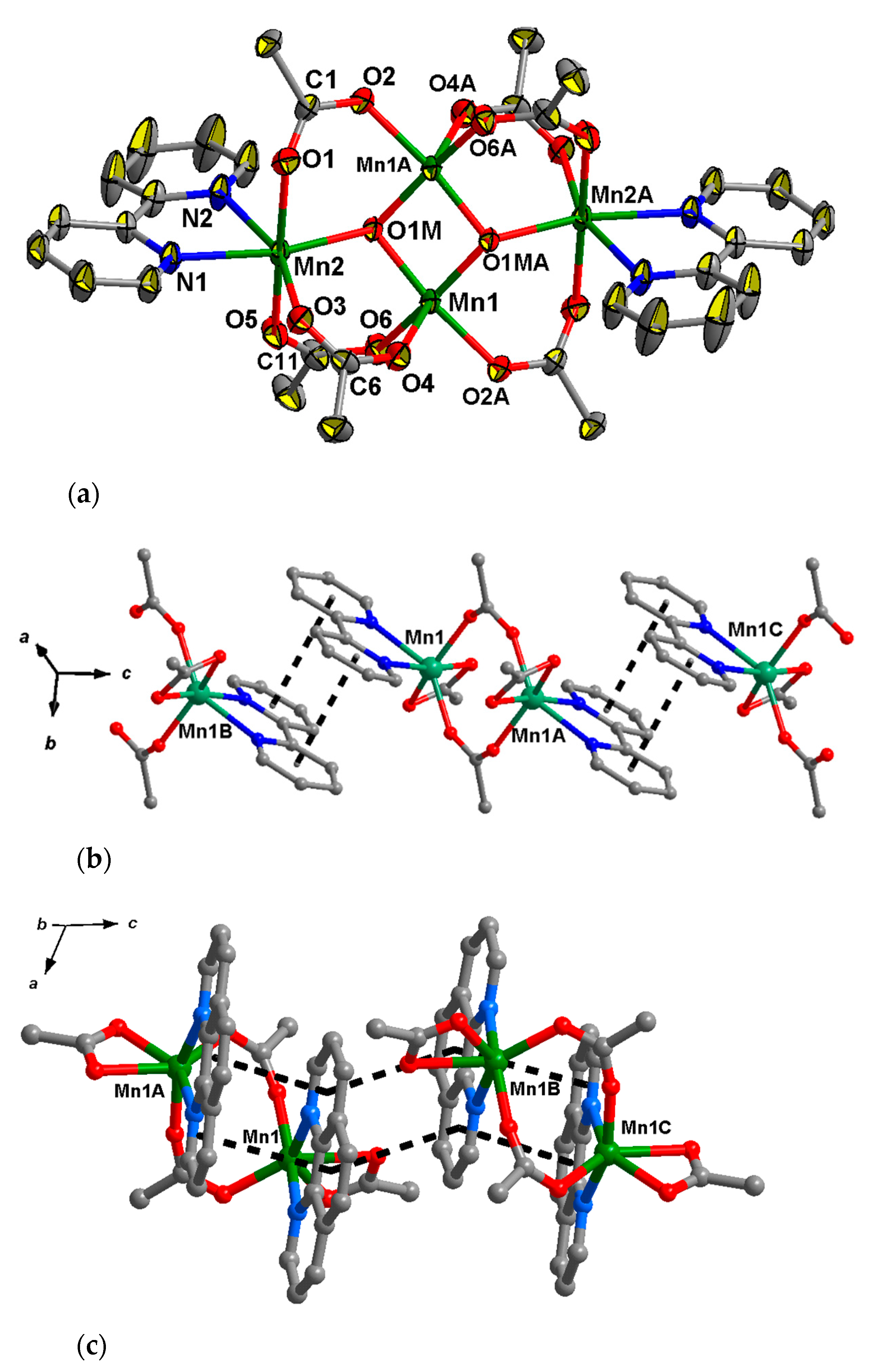


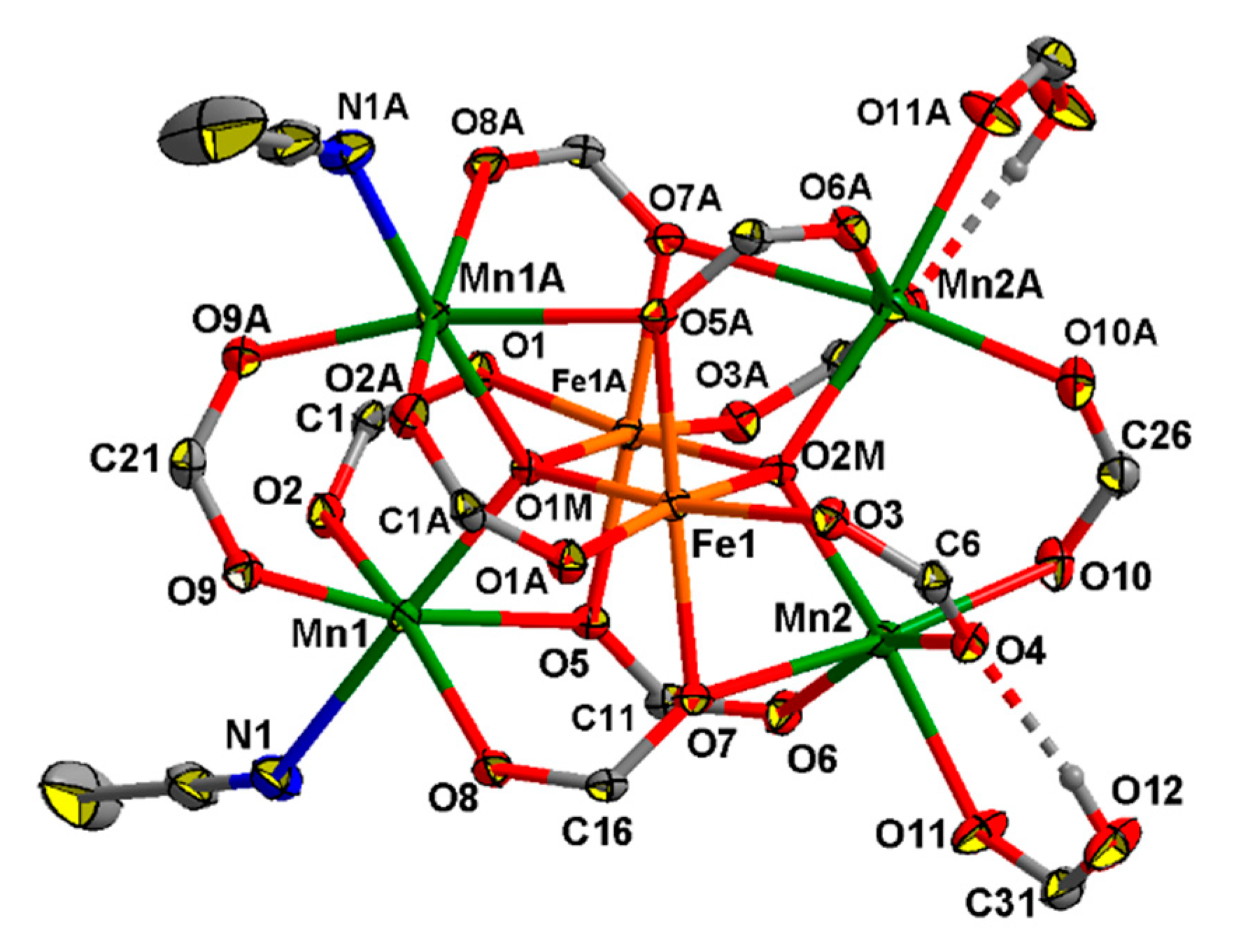




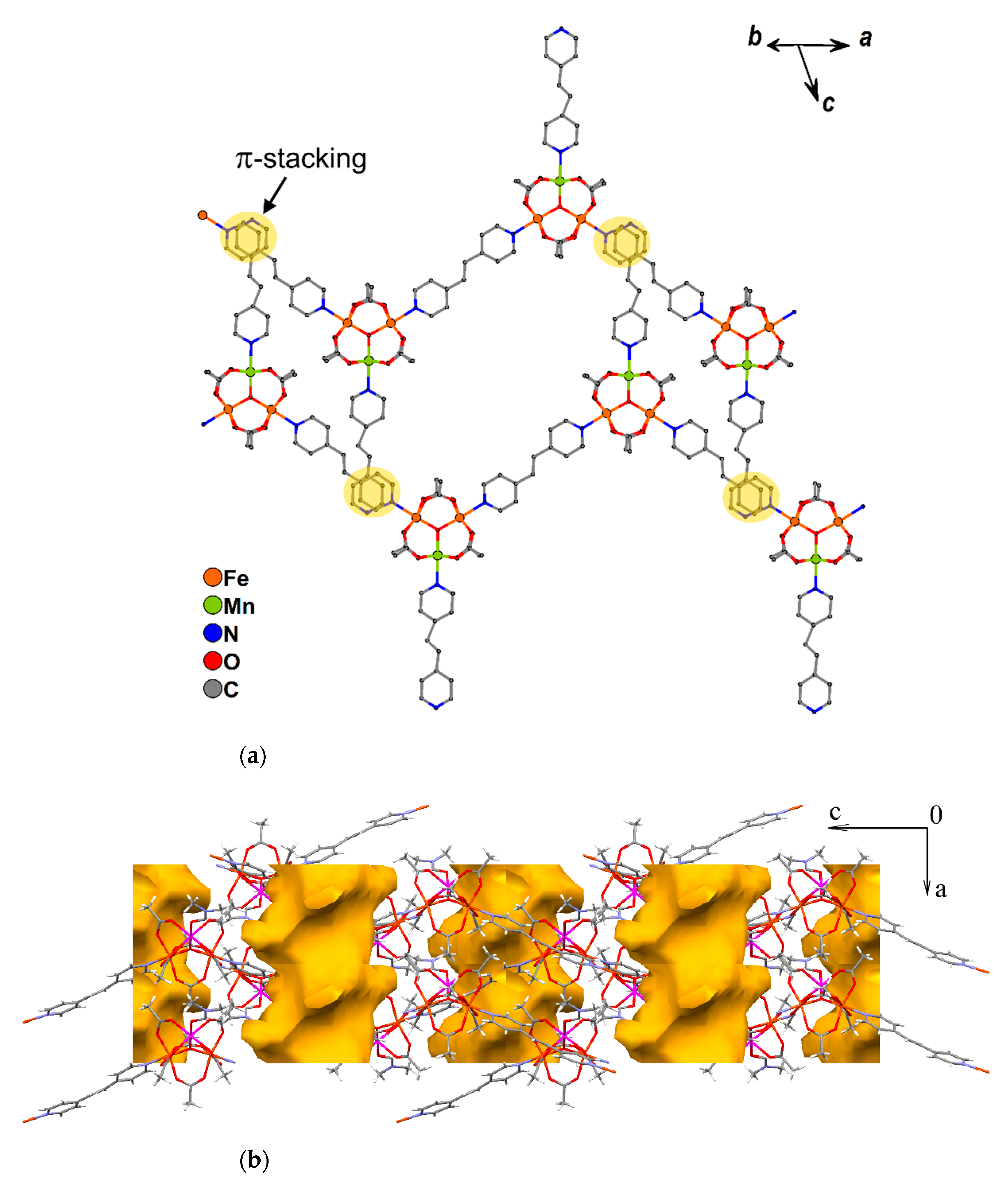

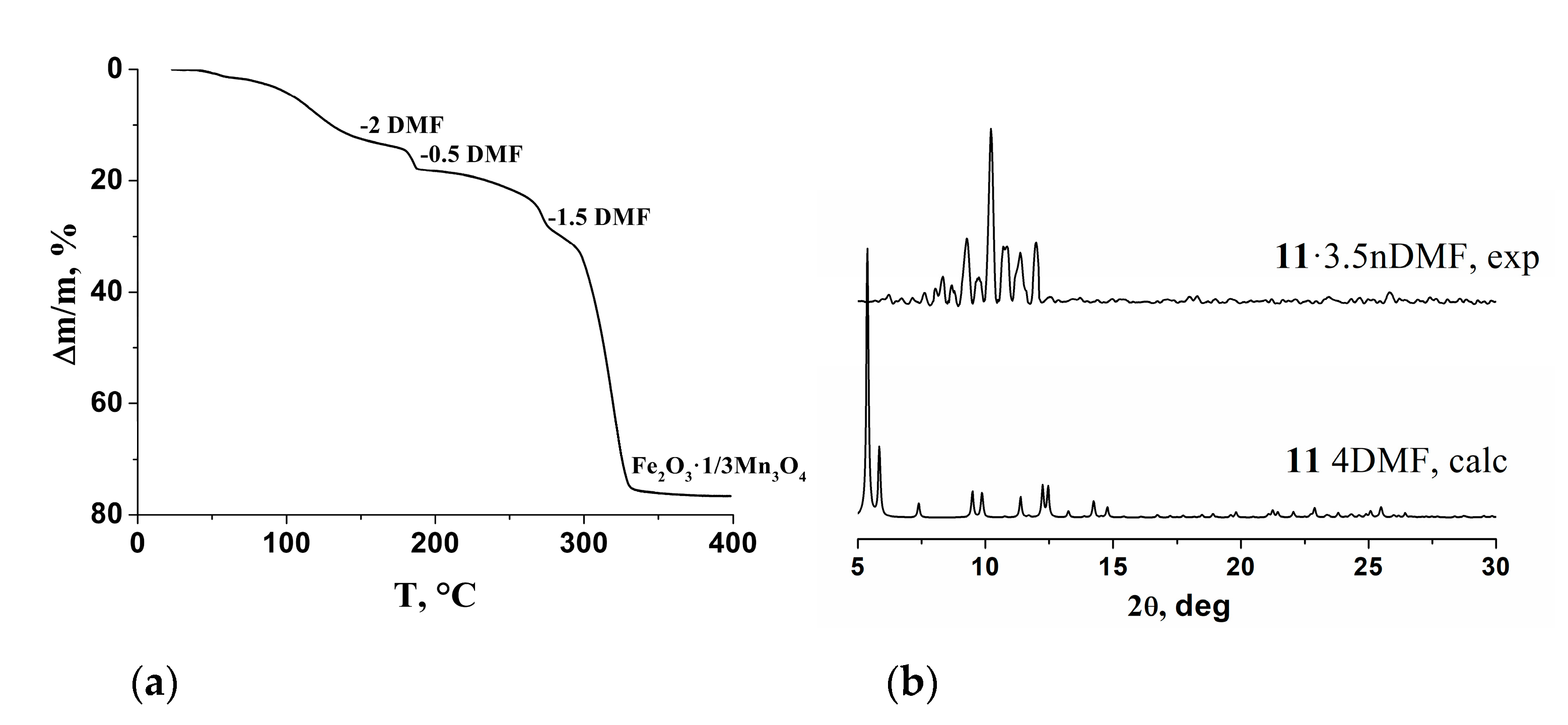





| Compound | G | d1 (cm−1) | e1 (cm−1) | d12 (cm−1) | e12 (cm−1) |
|---|---|---|---|---|---|
| 1 | 2.0023 | 0.00098 | 0.0105 | 0.0038 | 0.0067 |
| 2 | 2.0023 | 0.0368 | 0.0063 | 0.0347 | 0.0074 |
| 1 | 2 | 3·MeCN | 4·0.5MeCN | |
|---|---|---|---|---|
| Empirical formula | C40H52Mn2N4O8 | C44H52Mn2N4O8 | C52H73Mn4N5O14 | C55H71.5Mn4N4.5O14 |
| Formula weight (g·mol−1) | 826.73 | 874.77 | 1211.91 | 1239.42 |
| T/K | 150(2) | 296(2) | 296(2) | 296(2) |
| Crystal system | Monoclinic | Monoclinic | Monoclinic | Monoclinic |
| Space group | P21/c | C2/c | P21/c | P21/n |
| a (Å) | 11.676(6) | 19.821(16) | 12.7090(14) | 12.752(4) |
| b (Å) | 18.715(10) | 17.592(14) | 18.925(2) | 16.007(5) |
| c (Å) | 9.859(5) | 13.907(11) | 14.094(2) | 16.088(5) |
| α (o) | 90 | 90 | 90 | 90 |
| β (o) | 107.922(8) | 115.565(12) | 104.947(2) | 92.761(5) |
| γ (o) | 90 | 90 | 90 | 90 |
| V (Å3) | 2049.9(19) | 4374(6) | 3275.2(6) | 3280.0(16) |
| Z | 2 | 4 | 2 | 2 |
| Dcalc (g·cm−3) | 1.339 | 1.328 | 1.229 | 1.255 |
| μ (mm−1) | 0.67 | 0.632 | 0.811 | 0.811 |
| F(000) | 868 | 1832 | 1264 | 1290 |
| θ range for data collection (o) | 1.83 to 26.37 | 1.62 to 26.70 | 1.66 to 28.13 | 1.80 to 26.44 |
| Reflections collected | 14,993 | 16,361 | 20,634 | 29,369 |
| Reflections unique | 4194 | 4605 | 7934 | 6685 |
| Rint | 0.162 | 0.069 | 0.044 | 0.070 |
| Parameters | 257 | 262 | 409 | 439 |
| GOF | 0.900 | 1.037 | 1.010 | 1.004 |
| R1a [Io > 2σI)] | 0.052 | 0.059 | 0.053 | 0.059 |
| wR2b [Io > 2σI)] | 0.099 | 0.155 | 0.128 | 0.172 |
| 5 | 6 | 7·2MeCN | 8 | |
|---|---|---|---|---|
| Empirical formula | C66H108Mn6N8O22 | C58H98Mn6N4O22 | C47H78Mn4N6O15 | C72H128Fe2Mn4N6O26 |
| Formula weight (g·mol−1) | 1695.24 | 1533.04 | 1186.91 | 1825.26 |
| T/K | 173(2) | 296(2) | 173(2) | 150(2) |
| Crystal system | Monoclinic | Monoclinic | Triclinic | Monoclinic |
| Space group | P21/n | Pn | P‾1 | C2/c |
| a (Å) | 13.7821(10) | 14.404(3) | 13.4652(18) | 13.4462(15) |
| b (Å) | 21.676(2) | 16.331(3) | 13.7324(18) | 29.008(3) |
| c (Å) | 13.8218(10) | 16.330(3) | 18.150(2) | 23.868(3) |
| α (o) | 90 | 90 | 111.943(2) | 90 |
| β (o) | 98.7840(10) | 103.009(3) | 90.612(2) | 91.930(2) |
| γ (o) | 90 | 90 | 103.879(2) | 90 |
| V (Å3) | 4080.8(5) | 3742.6(14) | 3003.2(7) | 9304.3(18) |
| Z | 2 | 2 | 2 | 4 |
| Dcalc (g·cm−3) | 1.380 | 1.360 | 1.313 | 1.303 |
| μ (mm−1) | 0.971 | 1.050 | 0.884 | 0.900 |
| F(000) | 1772 | 1600 | 1244 | 3848 |
| θ range for data collection (o) | 1.76 to 26.60 | 1.25 to 28.27 | 1.22 to 26.90 | 1.40 to 28.28 |
| Reflections collected | 30,266 | 21,851 | 28,737 | 39,848 |
| Reflections unique | 8537 | 14,323 | 12,922 | 11,443 |
| Rint | 0.052 | 0.054 | 0.047 | 0.097 |
| Parameters | 460 | 813 | 716 | 542 |
| GOF | 0.990 | 0.969 | 1.052 | 1.025 |
| R1a [Io > 2σI)] | 0.046 | 0.082 | 0.056 | 0.058 |
| wR2b [Io > 2σI)] | 0.131 | 0.199 | 0.148 | 0.126 |
| 9 | 10 | 11 | |
|---|---|---|---|
| Empirical formula | C64H68Fe4Mn2N8O26 | C36H37.5Fe2MnN4O13 | C27H35Fe2MnN3O14 |
| Formula weight (g·mol−1) | 1698.54 | 900.84 | 792.22 |
| T/K | 293(2) | 293(2) | 293(2) |
| Crystal system | Monoclinic | Triclinic | Orthorhombic |
| Space group | I2/a | P‾1 | P212121 |
| a (Å) | 20.0570(6) | 12.889(5) | 8.0410(1) |
| b (Å) | 25.1754(7) | 14.469(5) | 19.572(1) |
| c (Å) | 34.7618(11) | 16.096(5) | 30.223(1) |
| α (o) | 90 | 88.749(5) | 90 |
| β (o) | 68.184(2) | 66.401(5) | 90 |
| γ (o) | 90 | 87.004(5) | 90 |
| V (Å3) | 17,374.0(9) | 2747.0(17) | 4756.5(7) |
| Z | 8 | 2 | 4 |
| Dcalc (g·cm−3) | 1.391 | 1.089 | 1.106 |
| μ (mm−1) | 1.012 | 0.796 | 0.912 |
| F(000) | 7472 | 925 | 1628 |
| θ range for data collection (o) | 5.09 to 25.56 | 2.76 to 26.37 | 1.24 to 25.68 |
| Reflections collected | 43,517 | 14,357 | 14,696 |
| Reflections unique | 15,023 | 9780 | 7253 |
| Rint | 0.147 | 0.041 | 0.100 |
| Parameters | 941 | 505 | 425 |
| GOF | 1.084 | 1.001 | 0.989 |
| R1a [Io > 2σI)] | 0.107 | 0.101 | 0.095 |
| wR2b [Io > 2σI)] | 0.199 | 0.291 | 0.248 |
Publisher’s Note: MDPI stays neutral with regard to jurisdictional claims in published maps and institutional affiliations. |
© 2021 by the authors. Licensee MDPI, Basel, Switzerland. This article is an open access article distributed under the terms and conditions of the Creative Commons Attribution (CC BY) license (http://creativecommons.org/licenses/by/4.0/).
Share and Cite
Polunin, R.A.; Evstifeev, I.S.; Cador, O.; Golhen, S.; Gavrilenko, K.S.; Lytvynenko, A.S.; Efimov, N.N.; Minin, V.V.; Bogomyakov, A.S.; Ouahab, L.; et al. Versatile Reactivity of MnII Complexes in Reactions with N-Donor Heterocycles: Metamorphosis of Labile Homometallic Pivalates vs. Assembling of Endurable Heterometallic Acetates. Molecules 2021, 26, 1021. https://doi.org/10.3390/molecules26041021
Polunin RA, Evstifeev IS, Cador O, Golhen S, Gavrilenko KS, Lytvynenko AS, Efimov NN, Minin VV, Bogomyakov AS, Ouahab L, et al. Versatile Reactivity of MnII Complexes in Reactions with N-Donor Heterocycles: Metamorphosis of Labile Homometallic Pivalates vs. Assembling of Endurable Heterometallic Acetates. Molecules. 2021; 26(4):1021. https://doi.org/10.3390/molecules26041021
Chicago/Turabian StylePolunin, Ruslan A., Igor S. Evstifeev, Olivier Cador, Stéphane Golhen, Konstantin S. Gavrilenko, Anton S. Lytvynenko, Nikolay N. Efimov, Vadim V. Minin, Artem S. Bogomyakov, Lahcène Ouahab, and et al. 2021. "Versatile Reactivity of MnII Complexes in Reactions with N-Donor Heterocycles: Metamorphosis of Labile Homometallic Pivalates vs. Assembling of Endurable Heterometallic Acetates" Molecules 26, no. 4: 1021. https://doi.org/10.3390/molecules26041021





